Why Does My Dog Squint One Eye?
If you’ve ever noticed your dog squinting one eye, it’s natural to feel concerned. While occasional squinting might not always signal a serious issue, it can sometimes indicate discomfort, injury, or an underlying health condition. Dogs rely on their eyes for navigation, communication, and play, so any changes in their vision or eye behavior should be taken seriously. Understanding the possible causes of this behavior—and knowing when to seek veterinary care—can help ensure your furry friend stays happy and healthy. Let’s dive into the reasons behind this curious behavior and explore how you can address it effectively.
Common Causes of Dog Squinting
There are several potential reasons why your dog might squint one eye. Identifying the cause is the first step toward providing the right care. Here are some common explanations:
Eye Irritation or Foreign Objects:
Dust, dirt, or small debris can get lodged in your dog’s eye, causing irritation and prompting them to squint.Corneal Ulcers:
A scratch or ulcer on the cornea can lead to significant discomfort, often resulting in squinting as a protective response.Conjunctivitis (Pink Eye):
Inflammation of the conjunctiva can cause redness, swelling, and squinting due to pain or sensitivity.Allergies:
Environmental allergens like pollen or dust mites can irritate your dog’s eyes, leading to squinting and watery discharge.Injury or Trauma:
Accidents during play or rough interactions can damage the eye, causing squinting as a sign of pain or injury.
Understanding these causes helps you determine whether the issue requires immediate attention or can be managed at home.

Signs That Accompany Squinting
Squinting alone may not tell the whole story. Observing additional symptoms can provide valuable clues about what’s troubling your dog.
Excessive Tearing or Discharge:
Watery eyes or unusual discharge can indicate infections, allergies, or foreign objects.Redness or Swelling:
Inflamed tissues around the eye often accompany conditions like conjunctivitis or trauma.Pawing at the Eye:
If your dog repeatedly paws at their face, it could mean they’re trying to relieve discomfort or remove an irritant.Cloudiness or Opacity:
A cloudy appearance in the eye might suggest a corneal injury or other serious condition requiring prompt care.Behavioral Changes:
Hesitation to engage in activities, lethargy, or signs of pain can indicate that the squinting is linked to a broader health issue.
By paying attention to these accompanying signs, you can better assess the severity of the situation and act accordingly.
Check this guide 👉Cat Scratched Dog Eye White Spot: Best 7 Expert Tips!
Check this guide 👉Why Do Dog Eyes Move While Sleeping? Best 7 Expert Tips!
Check this guide 👉Dog Eye Injury Treatment: Best 7 Expert Tips!
Possible Causes of Squinting | Recommended Actions |
|---|---|
Foreign object in the eye | Flush the eye gently with saline solution or consult a vet |
Corneal ulcer | Seek immediate veterinary care for diagnosis and treatment |
Conjunctivitis (Pink Eye) | Monitor symptoms; visit a vet if they worsen or persist |
Allergic reaction | Identify and remove allergens; use vet-recommended antihistamines |
Eye injury or trauma | Keep the area clean; schedule an emergency vet appointment |
How to Prevent Eye Problems in Dogs
Prevention is key to keeping your dog’s eyes healthy and minimizing the risk of issues that might cause squinting. These proactive steps can make a big difference:
Regular Eye Inspections:
Check your dog’s eyes weekly for signs of redness, swelling, or discharge. Early detection can prevent minor issues from worsening.Keep Their Environment Clean:
Reduce exposure to dust, smoke, and other irritants that could harm their eyes.Trim Facial Hair:
For breeds with long facial hair, trimming around the eyes prevents stray hairs from irritating the eyeball.Use Protective Gear:
During outdoor adventures, consider dog goggles to shield their eyes from wind, debris, or harsh sunlight.Schedule Routine Vet Visits:
Regular check-ups allow your vet to catch and address potential eye problems before they escalate.
Taking these preventive measures ensures your dog’s eyes stay bright, clear, and free from discomfort.
When to See a Veterinarian
While some cases of squinting can be resolved at home, others require professional intervention. Knowing when to seek veterinary care is crucial for your dog’s well-being.
Persistent Squinting:
If your dog continues to squint for more than 24 hours, it’s time to consult a vet.Visible Injuries or Cloudiness:
Any noticeable damage to the eye or cloudiness in the cornea warrants immediate attention.Severe Pain or Discomfort:
Signs of extreme distress, such as whining or avoiding touch near the eye, indicate a serious problem.Unusual Discharge:
Yellow, green, or bloody discharge suggests infection or injury that needs medical treatment.Accompanying Symptoms Like Lethargy:
If squinting is paired with vomiting, loss of appetite, or other systemic issues, seek urgent care.
Timely veterinary intervention can prevent complications and preserve your dog’s vision.
Common Mistakes to Avoid
Caring for a dog’s eyes requires caution and precision. Avoiding these common mistakes ensures you don’t inadvertently worsen the situation.
Using Human Eye Drops:
Over-the-counter human eye drops can irritate or harm your dog’s eyes. Always consult a vet before applying any medication.Ignoring Persistent Symptoms:
Assuming squinting will resolve on its own can delay treatment for serious conditions.Forcing Open Their Eye:
Trying to pry open a squinting eye can cause further injury or stress to your dog.Skipping Veterinary Care:
Home remedies aren’t always sufficient; skipping a vet visit can lead to complications.Overlooking Breed-Specific Risks:
Certain breeds are prone to eye issues, and neglecting preventative care increases their risk.
Avoiding these errors helps you provide the best care for your dog’s eyes.
How to Calm a Dog with Eye Discomfort
A dog experiencing eye discomfort may become anxious or restless. Here’s how to soothe them while addressing the issue:
Create a Quiet Space:
Isolate your dog in a calm, dimly lit area to reduce stimulation and stress.Offer Gentle Reassurance:
Speak softly and pet them gently to provide comfort without touching the affected area.Use a Cold Compress:
Apply a cool, damp cloth (not ice) to the area around the eye to reduce swelling and irritation.Distract with Toys:
Engage your dog with gentle play or chew toys to shift their focus away from discomfort.Administer Prescribed Medication:
Follow your vet’s instructions carefully when giving medications or treatments.
These calming techniques can ease your dog’s anxiety while you address their eye issues.
Long-Term Eye Health Tips
Maintaining your dog’s eye health isn’t just about reacting to problems—it’s also about fostering lifelong wellness.
Provide a Balanced Diet:
Nutrient-rich foods support overall eye health, including vitamins A, C, and E.Monitor Weight and Exercise Levels:
Obesity can exacerbate certain eye conditions, so maintaining a healthy weight is essential.Limit Exposure to Harsh Environments:
Protect your dog’s eyes from strong winds, chemicals, and direct sunlight during walks or outdoor play.Update Vaccinations Regularly:
Some diseases can affect eye health, so staying up-to-date on vaccinations is critical.Educate Yourself on Breed-Specific Needs:
Research your dog’s breed to understand unique eye care requirements and risks.
By adopting these habits, you’ll promote long-term eye health and happiness for your beloved companion.
Frequently Asked Questions About Dogs Squinting One Eye
Is it normal for my dog to squint occasionally?
Yes, occasional squinting is generally harmless and may simply reflect mood or environmental factors.
Should I take my dog to the vet if they keep squinting?
If the squinting persists or is accompanied by redness, swelling, or discharge, consult a veterinarian promptly.
Can allergies cause my dog to squint?
Absolutely. Allergies can lead to eye irritation, resulting in squinting or excessive tearing.
How can I tell if my dog’s squinting is playful or painful?
Look for accompanying signs; playful squinting is often brief and paired with wagging tails, while pain-related squinting tends to persist and involves visible distress.
Are certain breeds more prone to eye issues?
Yes, brachycephalic breeds like pugs and bulldogs are more susceptible to eye problems due to their facial structure.
Protecting Your Dog’s Vision and Comfort
Squinting in dogs can stem from a variety of causes, ranging from minor irritations to serious health concerns. By staying vigilant, recognizing symptoms, and seeking timely veterinary care when needed, you can safeguard your dog’s eye health and overall well-being. Remember, your dog relies on their eyes just as much as we do, and ensuring their comfort is a vital part of being a responsible pet owner. With proper care and attention, you can help your furry companion enjoy a lifetime of clear vision and joyful adventures.
Understanding Cryptosporidium in Cats: Best 7 Expert Tips! – Spot symptoms, treat safely, and stop parasite spread in your home.
Understanding Cryptosporidium in Dogs: Best 7 Expert Tips! – Learn symptoms, treatment & prevention for this stubborn gut parasite.
Understanding Syringomyelia in Cats: Best 7 Expert Tips! – Recognize signs, manage pain, and support your cat’s neurological health with vet-backed guidance.
Understanding Syringomyelia in Dogs: Best 7 Expert Tips! – Expert insights on symptoms, MRI diagnosis, pain management & quality of life.





